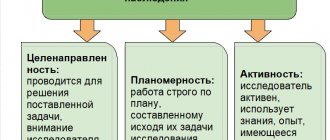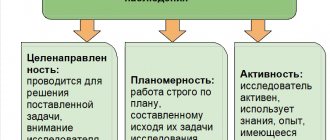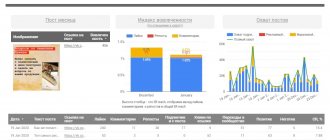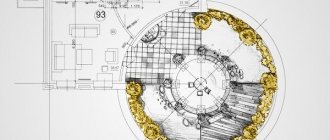One of the oldest research methods in psychology is observation.
Its active use began in the pre-Hippocratic period , when scientific knowledge was obtained through direct recording.
Subsequently, observation was effectively used in the study of types of temperament and nervous activity at the beginning of the twentieth century. It has not lost its effectiveness in modern psychology.
Why is the longitudinal method used in psychology? Find out about this from our article.
general information
The main subject of study of the science of psychology is the intangible component, the human psyche.
It is a complex system with many levels, connections and mutually influencing components.
This system is constantly in an active state and is exposed to external influences, so it can be very difficult to predict the development of certain psychological changes.
Therefore, the leading methods in psychology are observation and experiment.
Observation is a set of descriptive techniques that record the state of an object over a certain time.
For this description, certain sets of characteristics are formed: character traits, types of temperament, the nature of the psychological reaction, and the like.
For a more comprehensive approach, the use of experiment . This method is a psychological “experience”, which is also based on the use of this tool in the process of constructing this experience.
An experiment is most often used in conjunction with an observational method, which ensures the most complete collection of information.
Suggestion
By suggestion
is the process of inserting certain formulas, attitudes, positions or views into the person being studied outside of his conscious control. Suggestion can be direct or indirect communicative (verbal or emotional). The task of this method is to form the required state or point of view. The means of suggestion do not play a special role. The main task is to implement it. That is why emotional imprinting, confusion, distraction, intonation, remarks, and even turning off a person’s conscious control (hypnosis, alcohol, drugs) are widely used during suggestion.
From other appeals (requests, threats, instructions, demands, etc.), which are also methods of psychological influence, suggestion differs in involuntary and automatic reactions, and also in that it does not imply volitional efforts made consciously. In the process of suggestion, everything happens by itself. Suggestions affect every person, but to varying degrees.
There are several types of suggestions:
- Direct - influence through words (orders, commands, instructions);
- Indirect - hidden (intermediate actions, stimuli);
- Intentional;
- Unintentional;
- Positive;
- Negative.
There are different methods of suggestion:
- Techniques of direct suggestion - advice, command, instruction, order;
- Techniques of indirect suggestion - condemnation, approval, hint;
- Techniques of hidden suggestion - providing all options, illusion of choice, truism.
Initially, suggestion was used unconsciously by people whose communication skills had developed to a high level. Today, suggestion plays a huge role in psycho- and hypnotherapy. Very often this method is used in hypnosis or in other cases when a person is in a state of trance. Suggestions have been a part of human life since childhood, because... used in the process of education, advertising, politics, relationships, etc.
EXAMPLE:
A widely known example of suggestion is called the “placebo” effect, the phenomenon of improvement in a patient’s condition when taking a medicine that, in his opinion, has certain properties, when in fact it is a dummy. You can apply this method in practice. If, for example, one of your loved ones suddenly has a headache, give him a simple empty capsule under the guise of a headache remedy - after a while the “medicine” will work and the headache will stop. That's what it is .
Concept
This method is a method of understanding the world around us using sensory sensations analyzed over a certain period of time.
Scientifically, this method is defined as a coordinated system of scientifically based methods for studying an object in its natural environment.
At the same time, there is always a clear action plan , which includes goals, objectives and main characteristics of the description.
This process can be either retrospective, that is, analyzing past events, or present, that is, observing at the current moment in time.
In the practice of psychologists, momentary monitoring and analysis of the data obtained is more often used, since the psyche is a very dynamic object of observation.
Psychological testing
Psychological testing
belongs to the section of psychodiagnostics and deals with the study of psychological qualities and personality traits through the use of psychological tests. This method is often used in counseling, psychotherapy, and by employers when hiring. Psychological tests are needed when you need to learn about a person’s personality in more detail, which cannot be done through a conversation or survey.
The main characteristics of psychological tests are:
- Validity is the correspondence of the data obtained from the test to the characteristic for which the test is carried out;
- Reliability – consistency of the results obtained during repeated testing;
- Reliability is the property of a test to give true results, even with intentional or unintentional attempts to distort them by the subjects;
- Representativeness - compliance with norms.
A truly effective test is created through trial and modification (changing the number of questions, their composition and wording). The test must go through a multi-stage verification and adaptation procedure. An effective psychological test is a standardized test, based on the results of which it becomes possible to assess the psychophysiological and personal characteristics, as well as the knowledge, skills and abilities of the subject.
There are different types of tests:
- Career guidance tests - to determine a person’s predisposition to any type of activity or suitability for a position;
- Personality tests - to study character, needs, emotions, abilities and other personality traits;
- Intelligence tests - to study the degree of development of intelligence;
- Verbal tests - to study a person’s ability to describe actions performed in words;
- Achievement tests - to assess the level of mastery of knowledge and skills.
There are other test options aimed at studying a person and his personality traits: color tests, linguistic tests, questionnaires, handwriting analysis, psychometrics, lie detector, various diagnostic methods, etc.
Psychological tests are very convenient to use in everyday life in order to better know yourself or the people you care about.
EXAMPLE:
Tired of making money in a way that does not bring moral, psychological, or emotional satisfaction. Dreaming of finally quitting and doing something else. But you don’t know what. Find some career guidance tests and test yourself. It is quite possible that you will learn some things about yourself that you had no idea about before. The results of such tests can help you discover new facets of yourself and will help you understand what you would really like to do and what you are inclined to do. And knowing all this, it is much easier to find something you like. In addition, this is also good because a person, doing what he loves and enjoying it, becomes happier and more satisfied in life and, on top of everything else, begins to earn more.
Psychological testing promotes a deeper understanding of yourself, your needs and abilities, and often indicates the direction for further personal development.
Where is it used?
The observational method has the widest application in scientific and everyday activities. It is used for :
- descriptions of the current psychological situation in the team,
- analysis of basic personality characteristics,
- conducting an experiment to obtain descriptive data,
- independent use within the framework of self-observation,
- behavior control,
- monitoring the effectiveness of therapy or correction techniques,
- obtaining a database for drawing up a scientific or scientific hypothesis,
- processing the results of psychological research.
The variety of possible uses unifies this method, which is used in all sections: from occupational psychology to Gestalt therapy.
Subject of study
Depending on the goals of the study, the subject can be different objects. These include:
- Behavioral reactions of the individual and the team . These reactions can be observed both in interaction and by isolating specific ones for analysis of subjective reactions.
- Psychological verbal and nonverbal communications: verbal contact, facial expressions, emotional reflection. All these signals form a psychological portrait, which can also be the subject of observation.
- Patterns of human interaction . This includes conflicts, ways to resolve them, options for communication within the team, identifying the leader and the outsider. The subject in this case is communicative forms of behavior and mental characteristics that allow their implementation.
- Personal characteristics. When tracking an individual individual, the subject of research will be his mental activity and behavioral characteristics.
 Modeling, analysis of activity products. Biographical method.
Modeling, analysis of activity products. Biographical method.
ANALYSIS OF ACTIVITY PRODUCTS is a method of psychological research in which the researcher analyzes diary entries, archival materials, production documents, products of work or educational activities, etc. The actual behavior of the subject is not observed or measured.
23 pages, 11405 words
Chapter II. Methods of socio-psychological research
... methods of socio-psychological research, V.E. Kuzmin organizes the entire set of methods as follows: Methods of empirical research: observation, study of documents, survey, specialized methods of social psychology (sociometry, etc.), tests, experiment. Methods... types of behavioral responses or parameters of behavior. Regarding the time of research, observation is distinguished...
Mental modeling is a method of studying mental states, properties and processes, which consists of constructing models of mental phenomena, studying the functioning of these models and using the results obtained to predict and explain empirical facts. According to the completeness of the reflection of the object in the mo-
Delhi we can highlight the following. classes and subclasses of mental models: symbolic (figurative, verbal, mathematical), software (rigidly algorithmic, heuristic, block diagram), real (bionic).
Biographical methods in psychology are methods of research, diagnosis, correction and design of an individual’s life path.
Biographical methods are qualitative methods that are based on the fundamental hypothesis (assumption) that it is possible to restore and study social reality, social facts through the analysis of biographical materials and events stored in them, through assessments, reviews, opinions and attitudes. The basis of this hypothesis is the fact that human action is determined by passage through objective social conditions, and this is reflected in the subjective phenomenon of consciousness.
Kinds
This research method in psychology has several classifications. Depending on the attitude of people towards the researcher, hidden and open observation are distinguished.
When hidden, they do not notify about the study, this minimizes the influence of the specialist on the process, and also allows you to describe processes in their natural environment.
Overt or obvious includes an element of awareness: people know that they are being observed. This can both hide a natural reaction and exacerbate behavioral characteristics. This method also allows for more widespread scientific testing.
If the researcher is in the thick of the events of his observational process and influences its course and results, for example, by communicating with other people, conducting trainings or classes, then such observation is called involved.
If the psychologist remains aloof from what is happening and only records all the changes, then the experience is called third-party. This method is suitable for the information collection stage .
In relation to the object being studied, this method is divided into introspection or introspection and external research. Externality describes other people, and introspection is aimed at oneself.
In this case, the researcher and the subject are one person. In some cases, this method is used as an auxiliary method of therapy under the supervision of a psychologist.
According to the process time, they are distinguished:
- one-time,
- repeated or prolonged
- periodic or persistent.
Reinforcement
Reinforcements
is the instant reaction (positive or negative) of the researcher (or the environment) to the actions of the subject. The reaction must actually be instantaneous, so that the subject immediately has the opportunity to associate it with his action. If the reaction is positive, then this is a sign that you should continue to do or act in a similar way. If the reaction is negative, then vice versa.
Reinforcement can be of the following types:
- Positive - correct behavior/action is reinforced;
- Negative - incorrect behavior/action is prevented;
- Conscious;
- Unconscious;
- Natural - happens by accident (burn, electric shock, etc.);
- Intentional - conscious action (education, training);
- One-time;
- Systematic;
- Direct;
- Indirect;
- Basic;
- Secondary;
- Full;
- Partial.
Reinforcement is a huge part of human life. It, like suggestion, has been present in her since childhood in the process of upbringing and gaining life experience.
EXAMPLE:
Examples of reinforcement are around us at every step: if you put your hand in boiling water or try to touch the fire, you will certainly get burned - this is negative spontaneous reinforcement. The dog, following some command, receives a treat and repeats it with pleasure - positive intentional reinforcement. A child who gets a bad grade at school will be punished at home, and he will try not to give any more bad grades, because if he does, he will be punished again - one-time/systematic negative reinforcement. The bodybuilder knows that only regular training will give results - systematic positive reinforcement.
Research stages
The overwhelming majority of scientific tests are built according to a certain scheme. Observation also has its own system. It includes:
- Highlighting the purpose of the study . At this stage, the specialist formulates the main purpose of this descriptive process.
- Designation of tasks. Objectives are more detailed points of the main goal and are included in the work plan. It is drawn up in advance, forming the main methods and methods of implementation.
- Selection of study objects of observation. Select a group or one person who will constitute the target audience of the observation process.
- Definition of the subject of an observational experiment. This item depends on the purpose and audience being studied and identifies the psychological items (character features or reactions of a person or group) necessary for the description.
- Identification of the main impact factors, drawing up an observation plan . At this stage, information about observation conditions and possible errors and errors is selected. The duration of the process is also determined.
- Preliminary check of the selected method to clarify possible difficulties and errors.
- Direct registration process. Application of all selected methods.
- Obtaining results and their statistical processing.
- Formulating conclusions and answers to the questions posed.
Psychological consultation
Psychological consultation
- this is, as a rule, a one-time conversation between a psychologist and a client, orienting him in the current life situation. It implies a quick start to work, because... The client does not need any special preparation and the specialist, together with him, can understand the circumstances and outline steps to achieve the desired result.
The main problems for which people seek advice from a psychologist are:
- Relationships - jealousy, infidelity, communication difficulties, raising children;
- Individual problems - health, bad luck, self-organization;
- Work - dismissal, intolerance to criticism, low wages.
Psychological consultation consists of several stages:
- Contact;
- Request;
- Plan;
- Setting up for work;
- Implementation;
- Hometasks;
- Completion.
The method of psychological consultation, like any other method of psychology, consists of a combination of both theoretical and practical research methods. Today, there are various variations and types of consultations. Turning to a psychologist for help can be a solution to many life problems and a way out of difficult situations.
EXAMPLE:
The impetus for resorting to psychological consultation can be absolutely any life situation that a person cannot cope with on his own. These include problems at work, troubles in family relationships, depression, loss of interest in life, inability to get rid of bad habits, disharmony, struggle with oneself and many other reasons. Therefore, if you feel that you have been overcome and disturbed by some obsessive thoughts or conditions for a long period of time and you understand that you cannot cope with it alone, and there is no one nearby who could support you, then without a shadow of a doubt and embarrassment, seek help from a specialist. Today there are a huge number of offices, clinics and psychological assistance centers where experienced, highly qualified psychologists provide their services.
This concludes our consideration of the classification of the main methods of psychology. Other (auxiliary) methods include: the method of experimental psychological tests, the method of explanation and teaching, training, coaching, business and role-playing games, counseling, the method of correcting behavior and condition, the method of transforming living and working space and many others.
Any mental process must be considered by psychological science as it really is. And this presupposes its study in close connection with the surrounding world and the external conditions in which a person lives, because they are reflected in his psyche. Just as the reality around us is in constant movement and change, its reflection in the human psyche cannot be unchanged. In order to learn to more deeply understand the features of a person’s inner world, and the essence of things in general, one should come to the realization of the fact that one of the foundations of this understanding is precisely human psychology.
Nowadays, an incalculable amount of materials for studying psychological science and its features is freely available. In order for you not to get lost in all this diversity and know where to start studying, we suggest you familiarize yourself with the works of such authors as A. G. Maklakov, S. L. Rubinstein, Yu. B. Gippenreiter, A. V. Petrovsky, N. A. Rybnikov, S. Buhler, B. G. Ananyev, N.A. Loginova. And right now you can watch an interesting video on the topic of psychological methods:
Surveillance equipment
To carry out all the work, technical and analytical tools to record the results.
They use graduated scales, tests, and questionnaires. At the same time, category systems are distinguished.
They are a collection of specific category blocks that characterize a particular trait or process and make it possible to describe it based on a selection of data . This system is somewhat similar to tests, but does not give such a definitive result.
Example
A good example of such work in psychology is preliminary and periodic psychological testing of employees .
They make it possible to monitor both the professional suitability of the employee and his deformation during work activities.
Such surveillance is actively used in the military and law enforcement fields.
Another example is drawing up a psychological portrait of a person when seeking appropriate help. In this case, the method is one-time, based on descriptive information and reflects the state of a person at the current moment.
Advantages and disadvantages
The advantages of this method in psychology and psychodiagnostics include:
- simplicity,
- cheapness,
- wide coverage of subjects studied,
- a large selection of implementation tools,
- the possibility of both long-term and one-time experience,
- frequent use in other research methods.
Among the disadvantages are:
- high percentage of errors and errors,
- a large number of external influence factors,
- the need for the presence of a specialist researcher (impact on the process itself),
- difficulties in classifying results,
- multiplicity of evaluation stages (testing, survey), which reduces the reliability of the result,
- lack of uniform methods of implementation.










